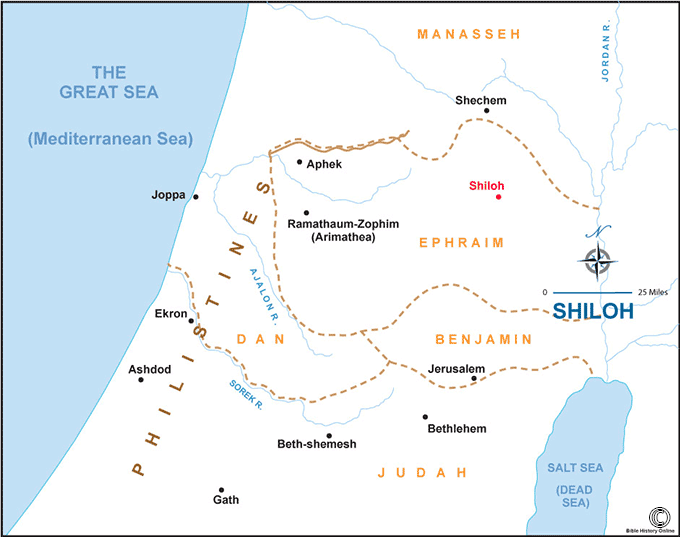|
Shiloh was a city in the same region as Shechem, which I have previously written about, therefore, it was once a Canaanite city before belonging to the Israelites, then the area belonged to the Samaritans, and was finally taken over by the Romans during the first century AD. Like Shechem, Shiloh was eventually destroyed and it is believed to have existed where Khirbet Seilun (Hebr. Tel Shiloh) is today. This is a “tell” or artificial mound that has formed from centuries of human refuse.
Judges 21:19 gives us the general whereabouts of the city of Shiloh: “But look, there is the annual festival of the Lord in Shiloh, which lies north of Bethel, east of the road that goes from Bethel to Shechem, and south of Lebonah.” Long before the Israelites arrived in Shiloh, it was a walled city with a religious shrine used by the Canaanites. When the Israelites took over the land, they set up their shrine: the tabernacle. “The whole assembly of the Israelites gathered at Shiloh and set up the tent of meeting there.” God had promised land to each of the tribes of Israel; however, by the time they had reached Shiloh, seven tribes had not yet received their inheritance. To help the tribes find their land, Joshua assembled the Israelites in Shiloh and sent three men from each tribe to survey the surrounding lands. On their return, “Joshua then cast lots for them in Shiloh in the presence of the Lord, and there he distributed the land to the Israelites according to their tribal divisions.” (Joshua 18:10) After the land of the tribes had been distributed, the Levites came to Joshua in Shiloh saying: “The Lord commanded through Moses that you give us towns to live in, with pasturelands for our livestock.” Throughout Joshua 21, the Levites were given the towns they had been promised. As a result of these events occurring at Shiloh, the city became an important location for the Israelites and, according to Jewish sources, the tabernacle remained there for 369 years. Israelites from all the tribes went on pilgrimages to Shiloh where they partook in major feasts and sacrifices to the Lord. On one occasion, when the Benjamites needed wives, they were instructed to “Go and hide in the vineyards and watch. When the young women of Shiloh come out to join in the dancing, rush from the vineyards and each of you seize one of them to be your wife. Then return to the land of Benjamin.” Judges 21:20-21) One of the regular attendees at annual festivals in Shiloh was Elkanah, the husband of Hannah and Peninnah. The latter had children, however, Hannah was barren. It was here in Shiloh where Hannah, weeping, was found by the Priest Eli who told her that God would grant her wish for a child.
One of the famous stories about Samuel as a boy is when the Lord calls for Samuel, however, mistaking the voice for Eli’s, Samuel rushes to see what the High Priest wanted of him. Eventually, Samuel understood who was calling him and “The Lord continued to appear at Shiloh, and there he revealed himself to Samuel through his word.” (1 Samuel 3:21) At the same time, Eli’s sons Hophni and Phineas were treating offerings to the Lord with contempt. They took some of the meat people had brought to the shrine for themselves and slept with the women who guarded the entrance to the tent. As a result, they were both killed. It is also thought this resulted in the loss of the Tabernacle at Shiloh when the Israelites were attacked by the Philistines. Some suggest the city was also destroyed at this time. By the time the Book of Jeremiah was written, it had been over 300 years since the destruction of Shiloh. Jeremiah used the fate of this city to warn the people of Judah and Jerusalem what God could do to them if they did not change their ways.
After the destruction of Shiloh, pilgrimages to the city stopped and the original site became lost. Since 1922, excavations have taken place that has gradually unearthed the city of Shiloh. A man named Aage Schmidt made the initial discovery and further investigations by a Danish team of archaeologists uncovered more of the area. Israel Finkelstein (b.1949) conducted the most extensive excavations in the 1980s and determined that Shiloh had been abandoned in around 1050 BC. Today, the ancient city of Shiloh can be visited by tourists, schools and groups, plus can also be used as the location of many Jewish ceremonies. A Tabernacle experience allows visitors to see what the area may have looked like through the aid of 3D glasses. Just for fun, visit this website for a virtual tour of the remains of the city of Shiloh. https://vt.panovision.co.il/shiloh/shiloh_vt.htm
0 Comments
Your comment will be posted after it is approved.
Leave a Reply. |
©Copyright
We are happy for you to use any material found here, however, please acknowledge the source: www.gantshillurc.co.uk AuthorRev'd Martin Wheadon Archives
June 2024
Categories
All
|

 RSS Feed
RSS Feed